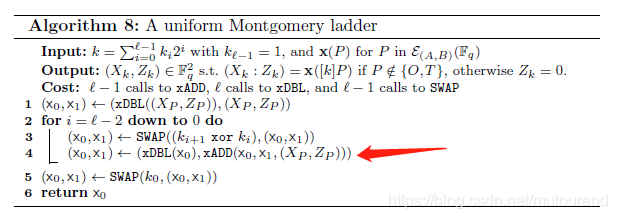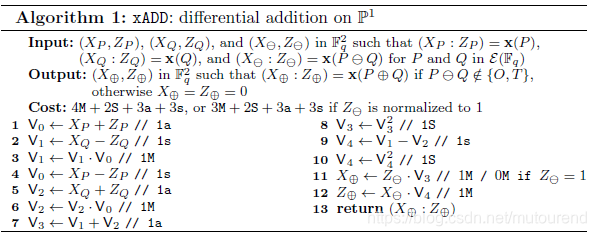1. Curve25519定义
The Curve25519 function is Fp-restricted x-coordinate scalar multiplication on E(Fp2 ), where p is the prime number p = 2255 − 19 and E is the elliptic curve y2 = x3 + 486662x2 + x.
对应的base point为(9,…)。
The order of the base point is a prime,
namely 2252 + 27742317777372353535851937790883648493.
FieldElement对应的域空间为[0, p-1),即为[0, 2255-19 - 1)。
https://github.com/dalek-cryptography/curve25519-dalek/blob/master/src/montgomery.rs 中的相应定义为
pub struct MontgomeryPoint(pub [u8;32]); //采用little-endian方式存储。
/// The X25519 basepoint, in `MontgomeryPoint` format.
pub const X25519_BASEPOINT: MontgomeryPoint =
MontgomeryPoint([0x09, 0x00, 0x00, 0x00, 0x00, 0x00, 0x00, 0x00,
0x00, 0x00, 0x00, 0x00, 0x00, 0x00, 0x00, 0x00,
0x00, 0x00, 0x00, 0x00, 0x00, 0x00, 0x00, 0x00,
0x00, 0x00, 0x00, 0x00, 0x00, 0x00, 0x00, 0x00]);
/// `BASEPOINT_ORDER` is the order of the Ristretto group and of the Ed25519 basepoint, i.e.,
/// $$
/// \ell = 2^\{252\} + 27742317777372353535851937790883648493.
/// $$
/// sage: hex(2^252+27742317777372353535851937790883648493)
/// '1000000000000000000000000000000014def9dea2f79cd65812631a5cf5d3ed'
pub const BASEPOINT_ORDER: Scalar = Scalar{
bytes: [
0xed, 0xd3, 0xf5, 0x5c, 0x1a, 0x63, 0x12, 0x58,
0xd6, 0x9c, 0xf7, 0xa2, 0xde, 0xf9, 0xde, 0x14,
0x00, 0x00, 0x00, 0x00, 0x00, 0x00, 0x00, 0x00,
0x00, 0x00, 0x00, 0x00, 0x00, 0x00, 0x00, 0x10,
],
};
2. MontgomeryPoint*Scalar
/// Multiply this `MontgomeryPoint` by a `Scalar`.
impl<'a, 'b> Mul<&'b Scalar> for &'a MontgomeryPoint {
type Output = MontgomeryPoint;
/// Given `self` \\( = u\_0(P) \\), and a `Scalar` \\(n\\), return \\( u\_0([n]P) \\).
fn mul(self, scalar: &'b Scalar) -> MontgomeryPoint {
// Algorithm 8 of Costello-Smith 2017。此处采用的是《Montgomery curves and their arithmetic》论文中的算法8。
let affine_u = FieldElement::from_bytes(&self.0); // 将[u8; 32]转换位[u64; 5]数组,且数组内每个元素仅存储51个bit。
let mut x0 = ProjectivePoint::identity(); //采用O和P点作为基础点,可保证loop为constant lenght.具体原因参见https://blog.youkuaiyun.com/mutourend/article/details/96426020
let mut x1 = ProjectivePoint {
U: affine_u, //X
W: FieldElement::one(), //Z,归一化了
};
let bits: [i8; 256] = scalar.bits(); //将[u8;32]转换为二进制位按little-endian形式存储[i8;256],虽然用的i8,其实元素只为0或1。
for i in (0..255).rev() { //254~0。scalar的bitlen l=256,循环的范围是从l-2~0
let choice: u8 = (bits[i + 1] ^ bits[i]) as u8; //异或
debug_assert!(choice == 0 || choice == 1); //保证bits中存储的元素仅为0或1.
ProjectivePoint::conditional_swap(&mut x0, &mut x1, choice.into());
differential_add_and_double(&mut x0, &mut x1, &affine_u);
}
ProjectivePoint::conditional_swap(&mut x0, &mut x1, Choice::from(bits[0] as u8));
x0.to_affine() //将输入(X:Z),转换为:$x=X/Z$,以[u8;32]格式存储。
}
}
其中FieldElement的定义如下:
FieldElement用数组形式存储[u64;5],因为Curve25519的p为2255-19,所以FieldElement每个数组元素仅需要用其中的51位即可,分别均匀的存储在5个元素中,即可表示域p内的所有值。
/// A `FieldElement` represents an element of the field
/// \\( \mathbb Z / (2\^{255} - 19)\\).
///
/// The `FieldElement` type is an alias for one of the platform-specific
/// implementations.
#[cfg(feature = "u64_backend")]
pub type FieldElement = backend::serial::u64::field::FieldElement51;
pub struct FieldElement51(pub (crate) [u64; 5]);
/// Load a `FieldElement51` from the low 255 bits of a 256-bit //256位是因为输入位[u8; 32] = 32*8 = 256 bit。
/// input.
/// 因为p=2^255-19,所以(2^255 - 18) mod p = 1
/// # Warning
///
/// This function does not check that the input used the canonical
/// representative. It masks the high bit, but it will happily
/// decode 2^255 - 18 to 1. Applications that require a canonical
/// encoding of every field element should decode, re-encode to
/// the canonical encoding, and check that the input was
/// canonical.
///
pub fn from_bytes(bytes: &[u8; 32]) -> FieldElement51 {
let load8 = |input: &[u8]| -> u64 {
(input[0] as u64)
| ((input[1] as u64) << 8)
| ((input[2] as u64) << 16)
| ((input[3] as u64) << 24)
| ((input[4] as u64) << 32)
| ((input[5] as u64) << 40)
| ((input[6] as u64) << 48)
| ((input[7] as u64) << 56)
};
let low_51_bit_mask = (1u64 << 51) - 1;
FieldElement51( //将[u8; 32]转换位[u64; 5]数组,且数组内每个元素仅存储51个bit。
// load bits [ 0, 64), no shift
[ load8(&bytes[ 0..]) & low_51_bit_mask
// load bits [ 48,112), shift to [ 51,112)
, (load8(&bytes[ 6..]) >> 3) & low_51_bit_mask
// load bits [ 96,160), shift to [102,160)
, (load8(&bytes[12..]) >> 6) & low_51_bit_mask
// load bits [152,216), shift to [153,216)
, (load8(&bytes[19..]) >> 1) & low_51_bit_mask
// load bits [192,256), shift to [204,112)
, (load8(&bytes[24..]) >> 12) & low_51_bit_mask
])
}
/// Construct zero.
pub fn zero() -> FieldElement51 {
FieldElement51([ 0, 0, 0, 0, 0 ])
}
/// Construct one.
pub fn one() -> FieldElement51 {
FieldElement51([ 1, 0, 0, 0, 0 ])
}
ProjectivePoint的定义如下:
其中ProjectivePoint的对应的是F映射(见Montgomery curve的运算(1)——add/double运算 第2节说明)
F
:
P
↦
{
(
x
p
:
1
)
i
f
P
=
(
x
p
:
y
p
:
1
)
(
1
:
0
)
i
f
P
=
O
=
(
0
:
1
:
0
)
F:P\mapsto\left\{\begin{matrix} (x_p:1) & if &P=(x_p:y_p:1) \\ (1:0)& if &P=O=(0:1:0) \end{matrix}\right.
F:P↦{(xp:1)(1:0)ififP=(xp:yp:1)P=O=(0:1:0)
即
F
(
(
X
:
Y
:
Z
)
)
=
(
X
:
Z
)
F((X:Y:Z))=(X:Z)
F((X:Y:Z))=(X:Z)仅对Z!=0的情况成立。
/// A `ProjectivePoint` holds a point on the projective line
/// \\( \mathbb P(\mathbb F\_p) \\), which we identify with the Kummer
/// line of the Montgomery curve.
#[derive(Copy, Clone, Debug)]
struct ProjectivePoint {
pub U: FieldElement,
pub W: FieldElement,
}
impl Identity for ProjectivePoint {
fn identity() -> ProjectivePoint {
ProjectivePoint {
U: FieldElement::one(),
W: FieldElement::zero(),
}
}
}
let bits: [i8; 256] = scalar.bits();对应为:
/// Get the bits of the scalar.
pub(crate) fn bits(&self) -> [i8; 256] { //将[u8;32]转换为二进制位按little-endian形式存储[i8;256],虽然用的i8,其实元素只为0或1。
let mut bits = [0i8; 256];
for i in 0..256 {
// As i runs from 0..256, the bottom 3 bits index the bit,
// while the upper bits index the byte.
bits[i] = ((self.bytes[i>>3] >> (i&7)) & 1u8) as i8; //每个byte内共8个bit元素,元素编号为从0~7,所以需要i>>3和i&7
}
bits
}
/// The `Scalar` struct holds an integer \\(s < 2\^{255} \\) which
/// represents an element of \\(\mathbb Z / \ell\\).
#[derive(Copy, Clone)]
pub struct Scalar {
/// `bytes` is a little-endian byte encoding of an integer representing a scalar modulo the
/// group order.
///
/// # Invariant
///
/// The integer representing this scalar must be bounded above by \\(2\^{255}\\), or
/// equivalently the high bit of `bytes[31]` must be zero.
///
/// This ensures that there is room for a carry bit when computing a NAF representation.
//
// XXX This is pub(crate) so we can write literal constants. If const fns were stable, we could
// make the Scalar constructors const fns and use those instead.
pub(crate) bytes: [u8; 32],
}
differential_add_and_double中,将xADD和xDBL放一个函数内实现,进一步优化了执行效率。



/// Perform the double-and-add step of the Montgomery ladder.
///
/// Given projective points
/// \\( (U\_P : W\_P) = u(P) \\),
/// \\( (U\_Q : W\_Q) = u(Q) \\),
/// and the affine difference
/// \\( u\_{P-Q} = u(P-Q) \\), set
/// $$
/// (U\_P : W\_P) \gets u([2]P)
/// $$
/// and
/// $$
/// (U\_Q : W\_Q) \gets u(P + Q).
/// $$
fn differential_add_and_double(
P: &mut ProjectivePoint,
Q: &mut ProjectivePoint,
affine_PmQ: &FieldElement,
) {
let t0 = &P.U + &P.W;
let t1 = &P.U - &P.W;
let t2 = &Q.U + &Q.W;
let t3 = &Q.U - &Q.W;
let t4 = t0.square(); // (U_P + W_P)^2 = U_P^2 + 2 U_P W_P + W_P^2
let t5 = t1.square(); // (U_P - W_P)^2 = U_P^2 - 2 U_P W_P + W_P^2
let t6 = &t4 - &t5; // 4 U_P W_P
let t7 = &t0 * &t3; // (U_P + W_P) (U_Q - W_Q) = U_P U_Q + W_P U_Q - U_P W_Q - W_P W_Q
let t8 = &t1 * &t2; // (U_P - W_P) (U_Q + W_Q) = U_P U_Q - W_P U_Q + U_P W_Q - W_P W_Q
let t9 = &t7 + &t8; // 2 (U_P U_Q - W_P W_Q)
let t10 = &t7 - &t8; // 2 (W_P U_Q - U_P W_Q)
let t11 = t9.square(); // 4 (U_P U_Q - W_P W_Q)^2
let t12 = t10.square(); // 4 (W_P U_Q - U_P W_Q)^2
let t13 = &APLUS2_OVER_FOUR * &t6; // (A + 2) U_P U_Q
let t14 = &t4 * &t5; // ((U_P + W_P)(U_P - W_P))^2 = (U_P^2 - W_P^2)^2
let t15 = &t13 + &t5; // (U_P - W_P)^2 + (A + 2) U_P W_P
let t16 = &t6 * &t15; // 4 (U_P W_P) ((U_P - W_P)^2 + (A + 2) U_P W_P)
let t17 = affine_PmQ * &t12; // U_D * 4 (W_P U_Q - U_P W_Q)^2
let t18 = t11; // W_D * 4 (U_P U_Q - W_P W_Q)^2
P.U = t14; // U_{P'} = (U_P + W_P)^2 (U_P - W_P)^2
P.W = t16; // W_{P'} = (4 U_P W_P) ((U_P - W_P)^2 + ((A + 2)/4) 4 U_P W_P)
Q.U = t18; // U_{Q'} = W_D * 4 (U_P U_Q - W_P W_Q)^2
Q.W = t17; // W_{Q'} = U_D * 4 (W_P U_Q - U_P W_Q)^2
}
to_affine函数将输入(X:Z),转换为:
x
=
X
/
Z
x=X/Z
x=X/Z,以[u8;32]格式存储。
impl ProjectivePoint {
/// Dehomogenize this point to affine coordinates.
///
/// # Return
///
/// * \\( u = U / W \\) if \\( W \neq 0 \\);
/// * \\( 0 \\) if \\( W \eq 0 \\);
pub fn to_affine(&self) -> MontgomeryPoint {
let u = &self.U * &self.W.invert(); //此处invert为FieldElement内的invert,乘积为两个FieldElement的乘积。
MontgomeryPoint(u.to_bytes())
}
}
3. Scalar*MontgomeryPoint
impl<'a, 'b> Mul<&'b MontgomeryPoint> for &'a Scalar {
type Output = MontgomeryPoint;
fn mul(self, point: &'b MontgomeryPoint) -> MontgomeryPoint {
point * self //转换调用2算法,MontgomeryPoint*Scalar
}
}
4. MontgomeryPoint *=Scalar
impl<'b> MulAssign<&'b Scalar> for MontgomeryPoint {
fn mul_assign(&mut self, scalar: &'b Scalar) {
*self = (self as &MontgomeryPoint) * scalar; //转换调用2算法,MontgomeryPoint*Scalar
}
}
参考资料:
[1] 论文《Montgomery curves and their arithmetic》




 本文详细介绍了Curve25519椭圆曲线的定义及其在密码学中的应用,包括标量乘法的实现算法、关键数据结构如MontgomeryPoint和FieldElement的定义与操作方法。
本文详细介绍了Curve25519椭圆曲线的定义及其在密码学中的应用,包括标量乘法的实现算法、关键数据结构如MontgomeryPoint和FieldElement的定义与操作方法。
















 1757
1757

 被折叠的 条评论
为什么被折叠?
被折叠的 条评论
为什么被折叠?








